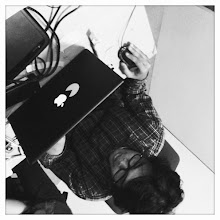1) Technical - Hardware/Software.
2) Design Approach.
3) Proposal Content.
I will start with Technical first. Basically this will cover all the Hardware and Software that are required in order to create this installation.
Since I'm doing DIY Multi-touch Technology, there are few things I need to do research on.
Main hardware:
i) The surface method.
ii) Surface materials
iii) Surface diffuser
iv) Projector
v) Infrared camera
vi) Infrared light.
Software:
vii) Blob tracker.
viii) Flash AS3
i) Surface Method.
There are 3 types of infrared surface technique in Multi-touch:
Frustrated Total Internal Reflection(FTIR)

Total Internal Reflection describes a condition present in certain materials when light enters one material from another material with a higher refractive index, at an angle of incidence greater than a specific angle (Gettys, Keller and Skove 1989, p.799)
This is the method of flooding the inside of a piece of acrylic with infrared light by trapping the light rays within the acrylic using the principle of Total Internal Reflection. When the user comes into contact with the surface, the light rays are said to be frustrated, since they can now pass through into the contact material (usually skin), and the reflection is no longer total at that point.
Diffused Illumination (DI)

Diffused Illumination (DI) comes in two main forms. Front Diffused Illumination and Rear Diffused Illumination. Both techniques use the same basic principles.
Infrared light is shined at the screen from below the touch surface. A diffuser is placed on top or on bottom of the touch surface. When an object touches the surface it reflects more light than the diffuser or objects in the background; the extra light is sensed by a camera. Depending on the diffuser, this method can also detect hover and objects placed on the surface.
Laser Light Plane Illumination (LLP)

Infrared light from a laser(s) is shined just above the surface. The laser plane of light is about 1mm thick and is positioned right above the surface, when the finger just touches it, it will hit the tip of the finger which will register as a IR blob.
Conclusion
After consideration I choose Diffuse Illumination as a Infrared Surface. These are the reasons:
- No need for a compliant surface, just an diffuser/projection on top/bottom
- Can use any transparent material like glass (not just acrylic)
- No LED frame required
- No soldering (I can buy the IR- Illuminators ready to go)
- Can track objects, fingers, fiducials, hovering.
- I'm using enclose box
- Easier to setup
However there are few cons:
- Difficult to get even illumination
- Blobs have lower contrast (harder
to pick up by software)
- Greater chance of ‘false blobs’
Reference
http://nuigroup.com/forums/viewthread/1982/
http://wiki.nuigroup.com/Laser_Light_Plane_Illumination_%28LLP%29
http://wiki.nuigroup.com/Diffused_Illumination
http://wiki.nuigroup.com/FTIR


No comments:
Post a Comment